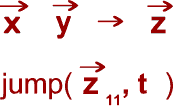
This is the formula for the most basic element of visual consciousness. Copying the formula out, time after time, produces a computer program. If the Church-Turing thesis is correct, then a sufficiently complex program can solve any problem that the human mind can solve. And if I am correct, then some quite simple programs can make a robot visually conscious. However, giving a robot visual consciousness comparable to a human being would take a huge effort.
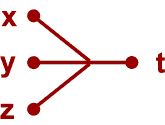
The formula for the most basic element of visual consciousness can be translated into a shape like a neuron. This artificial neuron works a little bit like a neuron in an animal's brain. Interestingly, if a whole computer program is translated into a collection of artificial neurons, then the neurons are organised into fibre bundles like those in an animal's brain.
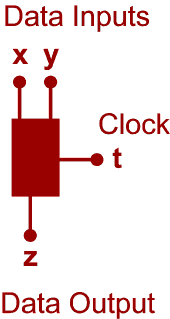
The formula for the most basic element of visual consciousness can be translated into a shape like a logic gate in a computer. This artificial gate works quite like an electronic gate. But if a whole computer program is translated into a collection of artificial logic gates there is a problem. The wires tend to cross when laid out on the 2D surface of a computer chip. This short circuits the chip. Fortunately, if the data and clock are made to access memory like a von Neumann computer, then the wires are uncrossed and there is no problem. So the artificial gate is very much like the gates in a digital computer. Alternatively, the wires can be uncrossed by laying them out in a volume of 3D space, like the neurons in an animal's brain. If animals had address and data busses in their heads, their brains could be laid out in a much simpler fashion.
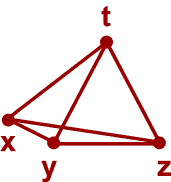
The formula for the most basic element of visual consciousness can be translated into one of the simplest geometrical shapes - a simplex. The formula translates into a 3D tetrahedron, but is embedded in a 4D space that distorts shapes so that they look like they would in perspective. This is the perspective simplex, or perspex, for short. The perspex is astonishingly versatile. Any shape can be built up by a collection of perspexes and the collection can be manipulated to show how the shape looks from any viewpoint. This makes it an ideal data structure to use in a program that can see. The perspex can also describe any motion of a shape, so one perspex can manipulate another. A program that can see shapes can also see motions.
The perspex is an exact translation of the formula, so it can be used to write computer programs. These programs operate in a perfect von Neumann computer that addresses the 4D space without the need for an address or data bus, and without unnecessary neural axons and fibre bundles that consume neural tissue in their effort to shunt data around a 3D volume of brain matter. The perspex made up of x, y, z, and t operates in three-address instructions. In the first instruction it reads two perspexes, via x and y, then writes the result via the perspex z. In the second instruction it examines the result via z and passes control under the influence of t to a third perspex. The new perspex then repeats these actions. It is like a relay race with control passing like the baton from one perspex to the next, and with the results left on the track like footprints. If only one perspex starts this relay race then the network of perspexes behaves like a serial computer, but if several start, the network behaves like a parallel computer, or like an animal's brain, with control flashing through a myriad neurons and with the answers spread throughout the brain.
A program that can see objects and motions and its own programs comes very close to being visually conscious. If it has the wherewithal to plan to put one building block on top of another, it can equally plan to change its program from an unstructured chaos corresponding to the world it sees, into a more structured program of its own devising. With the addition of feelings derived from the behaviour of its physical computer and body, a robot programmed with perspexes might eventually posses a visual consciousness to match human visual consciousness. And, naturally, visual consciousness can be programmed to spill over into any other sensory modality, such as hearing, taste, smell, touch, and the more exotic senses that a robot might posses.
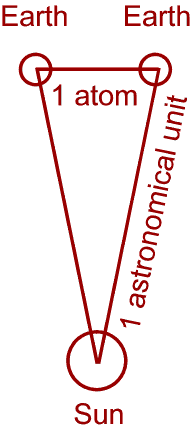
Perspexes can be used to compute mundane things, like the exact numerical rotation which will carry Earth about its orbit by a chord equal to the diameter of an atom of hydrogen. I do this to impress visitors, but astronomers might like to do it to compute the angular separation of stars, so they can work out the age of the universe and find black holes. You might prefer us to work out accurately how close an asteroid is going to come to Earth, and so work out if mankind need do anything to avoid oblivion.
This is worthy science, but such programs are not visually conscious, even though they are programmed in perspexes. Why not?
Because, to be visually conscious of something one must be able to see the thing and describe it, thereby obtaining information from an image, and also be able to point out in an image what is described, thereby putting information into an image. For example, one must be able to look at astronomical photographs from a space telescope and be able to say, "here is Earth", "here is an asteroid" and be able to point to a photograph and say, "the asteroid will go here and hit Earth". If a person were to look at the photographs and could not say where the asteroid would go one would not say that the person is visually conscious of the path of the asteroid. Conversely, if the person could point out the path of the asteroid, but could not see that the thing it is going to hit is called "Earth" one would not say that the person is visually conscious of the Earth in the photographs. Few programs can work both ways between an image and a description, but the amazing versatility of perspexes will, I hope, make it easier to write such programs that can do this for themselves. After that, I will start out on the long road of making a robot that is able to see its own thoughts, feelings, motivations, body, surroundings, and so on. Perhaps you will join me on this journey?